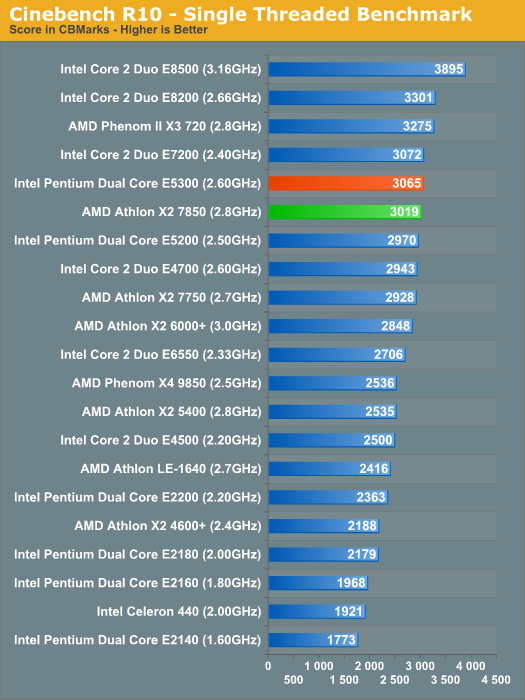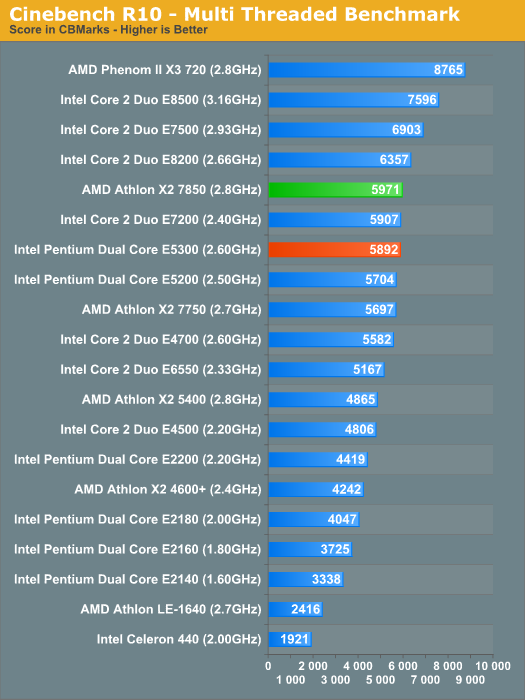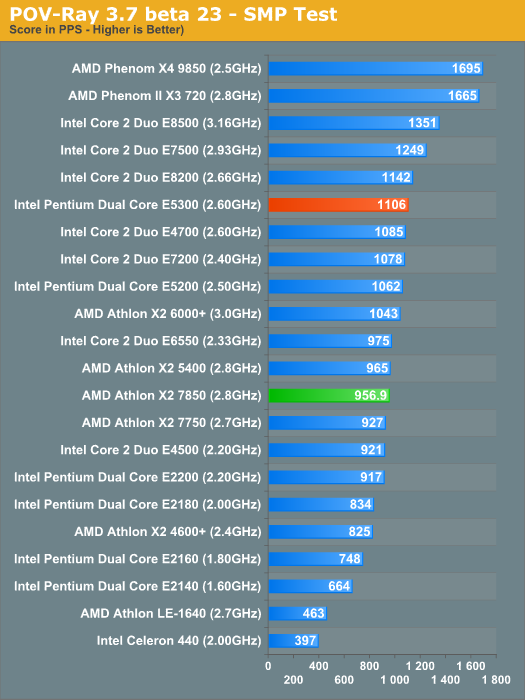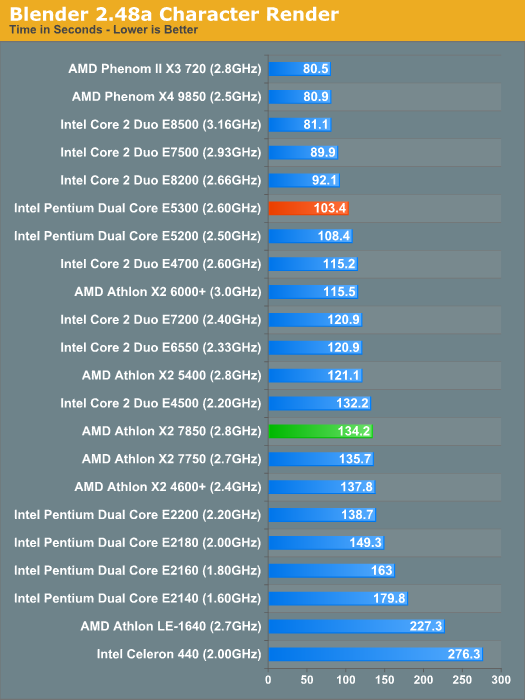AMD Athlon X2 7850 vs. Intel Pentium E5300: Choosing the Best $70 CPU
by Anand Lal Shimpi on April 28, 2009 11:00 AM EST- Posted in
- CPUs
3dsmax 9 - SPECapc 3dsmax CPU Rendering Test
Today's desktop processors are more than fast enough to do professional level 3D rendering at home. To look at performance under 3dsmax we ran the SPECapc 3dsmax 8 benchmark (only the CPU rendering tests) under 3dsmax 9 SP1. The results reported are the rendering composite scores:

Performance under 3dsmax has the E5300 and E5200 at a significant advantage over the Athlon X2 7850. The E5300 is 14% quicker than the X2.
Cinebench R10
Created by the Cinema 4D folks we have Cinebench, a popular 3D rendering benchmark that gives us both single and multi-threaded 3D rendering results.


Cinebench performance ends up being a wash between the two parts, performance in both single and multithreaded versions of the test are virtually identical.
POV-Ray 3.73 beta 23 Ray Tracing Performance
POV-Ray is a popular, open-source raytracing application that also doubles as a great tool to measure CPU floating point performance.
I ran the SMP benchmark in beta 23 of POV-Ray 3.73. The numbers reported are the final score in pixels per second.

POV-Ray shows a nearly 16% performance advantage for Intel’s architecture over the Athlon X2.
Blender 2.48a
Blender is an open source 3D modeling application. Our benchmark here simply times how long it takes to render a character that comes with the application.

The performance advantage extends to over 20% under Blender. It looks like for video encoding or 3D rendering tasks, the Pentium E5300 is a much better option than the Athlon X2 7850.










55 Comments
View All Comments
evanwhat - Tuesday, May 12, 2009 - link
Please revisit this debate with overclocking factored into the picture.Many thanks,
-Evan
Patrick Wolf - Monday, May 4, 2009 - link
Why even bother with single core CPU's anymore? Why can't you throw a $50 Celeron e1400 in there? How does it compare to the lower end X2's and P4's?orenlevy - Saturday, May 2, 2009 - link
It seems you are benching the wrong hardware! You are far from the market guys.... the whole story is changing when comparing low end mobos. like G31or n73 for Intel. And 740V\g or 780G for AMD. It change totally the latency timing specially in Intel setup-there is no on die controller.agawtrip - Friday, May 1, 2009 - link
people who buy these CPUs are those on a budget.you only have two setups here - budget setups
intel e5200/e5300 + 9300/9400 boards
AMD x27750/7850 + 780G
now which is faster and has a lower price?
9300/9400 boards are faster than 780g but on a higher price. then if you're really on a budget you'll have to go for AMD set-up. if you still have some extra cash, you can put it on a video card, or extra memory or go for tri-core which will give a real nice performance, faster than OCed e5200/e5300.
dingetje - Tuesday, April 28, 2009 - link
sorry to say this, but leaving overclocking out of the equation means: FAILbigsnyder - Tuesday, April 28, 2009 - link
The article keeps referencing the e6400 as a comparison, but I don't see it in the charts from the original core 2 duo review. Am I missing something here?v12v12 - Tuesday, April 28, 2009 - link
I don't wanna toot a moral high-horse, but... I noticed the word "crippled" in the article; why on earth (aside from being cheap or broke and needing a better job) would you waste money on a crippled piece of hard ware.Let me break this down: So a manufacturer produces a product X with 4 cores or whatever. Now they say "hey we've created this product and want a certain amount of compensation." So, the cost of production, advertising blah blah is all factored into this selling price. 4 cores yadda yadda...
Now some really smart mofo says "hey we can sell the same exact product from the same fab line, but we'll just 'disable' the other cores and rebadge it as a lower model, even though it costs us little to nothing to do this since it's all the same hardware!!!" Sweet deal for AMD/Intel etc.
Can you see where this is going? I would never buy something that someone purposefully disabled cores that are on the chip, that could be active and working perfectly, but they've decided to be greedy (not necessarily bad) and disable them unless you pay another higher fee. So all someone (them) has to do is flip a switch or connect some traces and boom you have the true product as intended. So in essence, it costs them little to nothing to cripple this thing, yet charge a bit less for another “product,” which in reality is NOT another product, it's the same dang thing but crippled.
Smart business practice yes... good for the consumer's wallet? No. Profits Vs Consumers. Often times consumers (cattle) find themselves rationalizing or justifying these shady profit-practices, BUT ask yourselves; would they or do they have much concern for your wallet... Yes they do, they are concerned with getting as much money from you as they can regardless of performance or not. 2 active cores or 4... they don't care so long as you're paying as much as they can get.. It costs them X to make this CPU, and they want to find a reasonable profit margin Vs costs of production, but yet they can still sell you the SAME hardware, just switched off at a MUCH lower price??? WOW these guys are deviously intelligent. Can’t say the same about many of their customers…
:-/
chowmanga - Tuesday, April 28, 2009 - link
You're missing the point of disabling cores and selling them for cheaper price. Silicone yields aren't 100%. A lot of times these cpu's come out with defected so rather than scrapping the whole thing, they rebadge it them and sell them for cheap. They aren't necessarily "active and working perfectly"kopilka - Saturday, January 16, 2010 - link
Athlon outside competition, Athlon won the market!http://www.safegeneric.com">http://www.safegeneric.com
Doc01 - Tuesday, July 27, 2010 - link
Athlon has surpassed all expectations, Athlon outside competition.<a href="http://www.salesgeneric.net">http:...